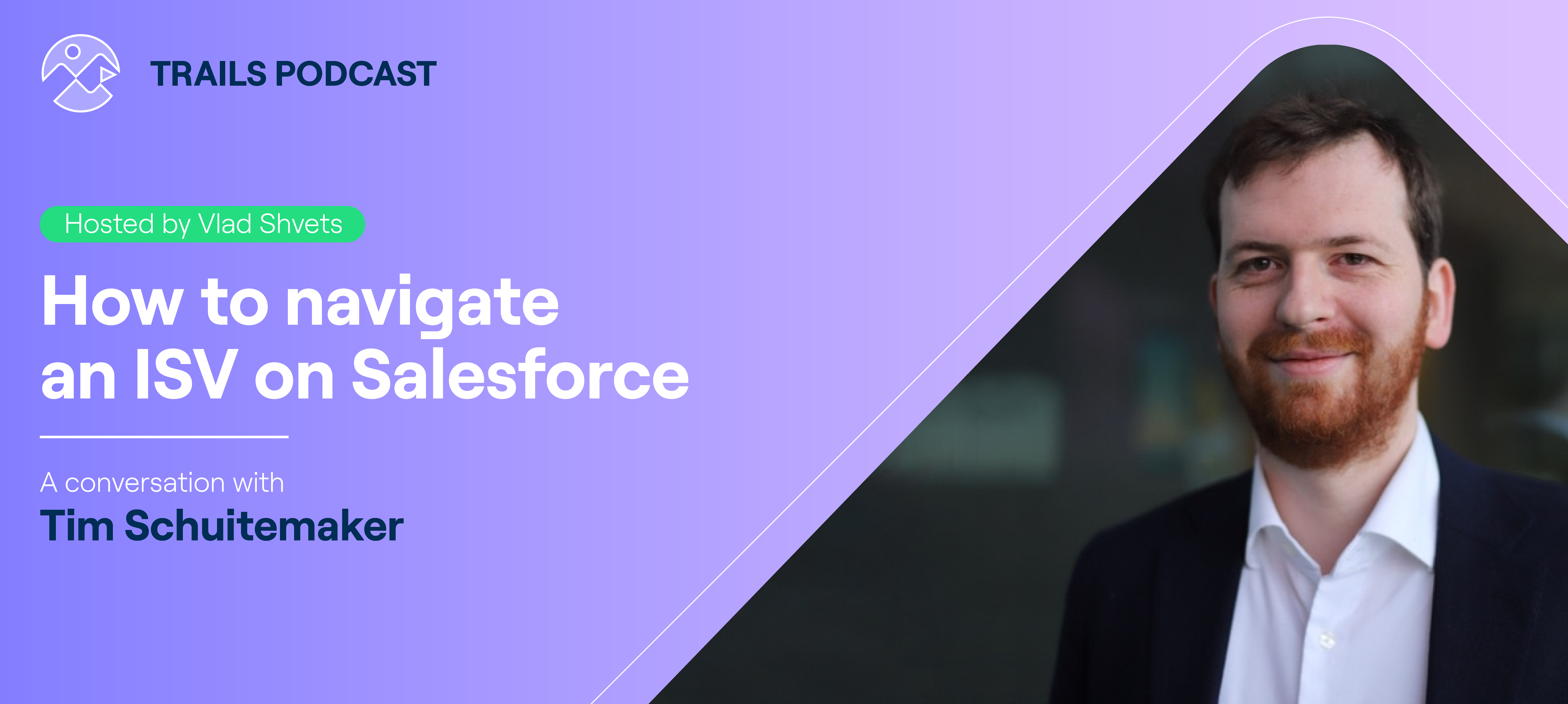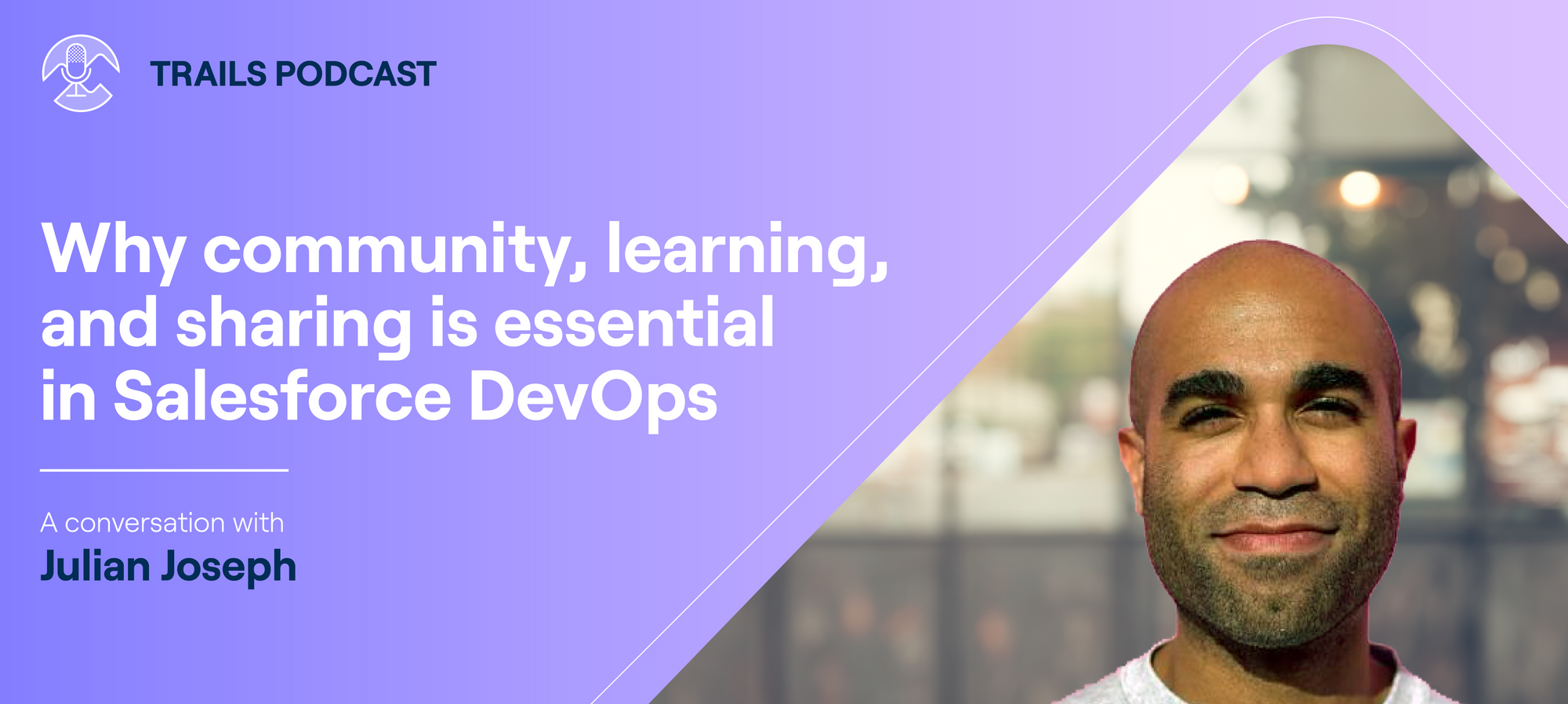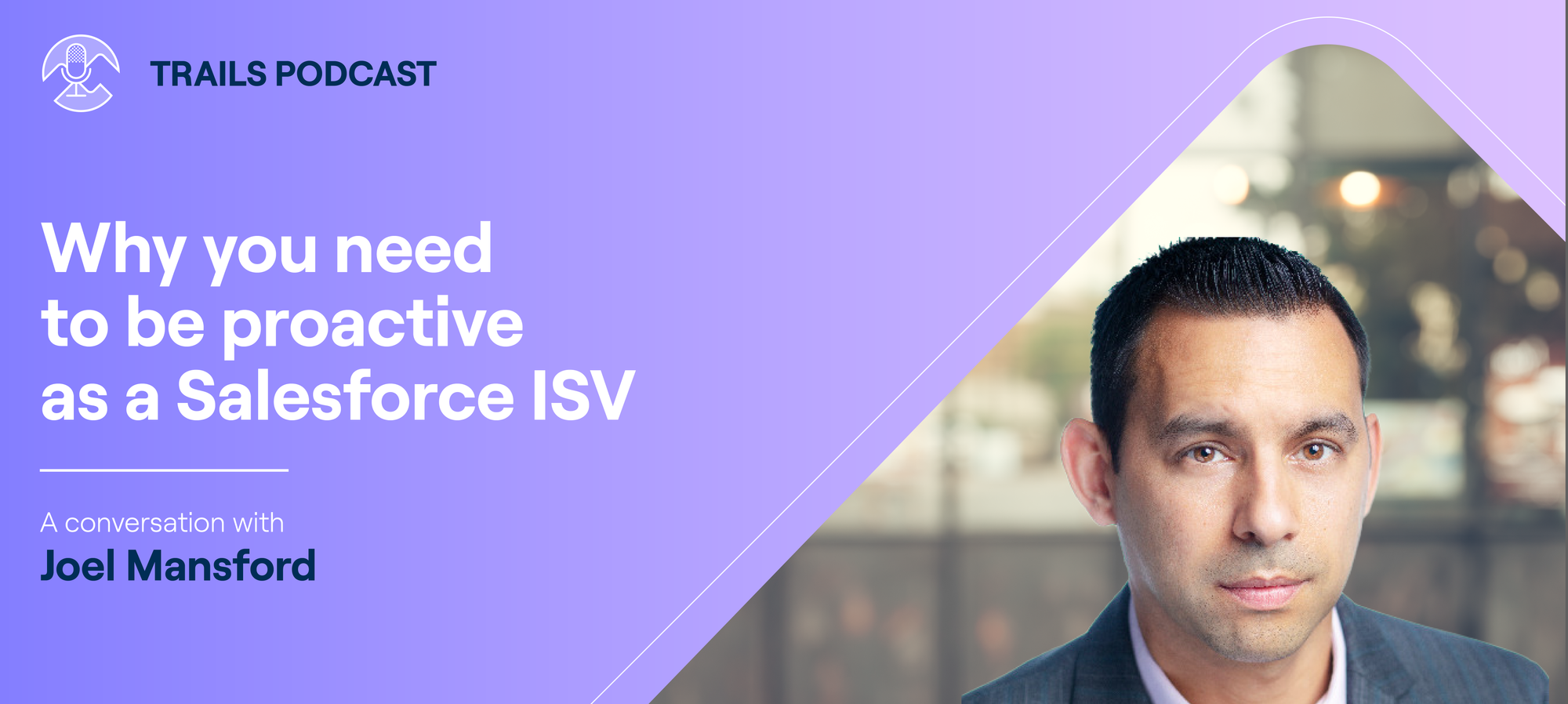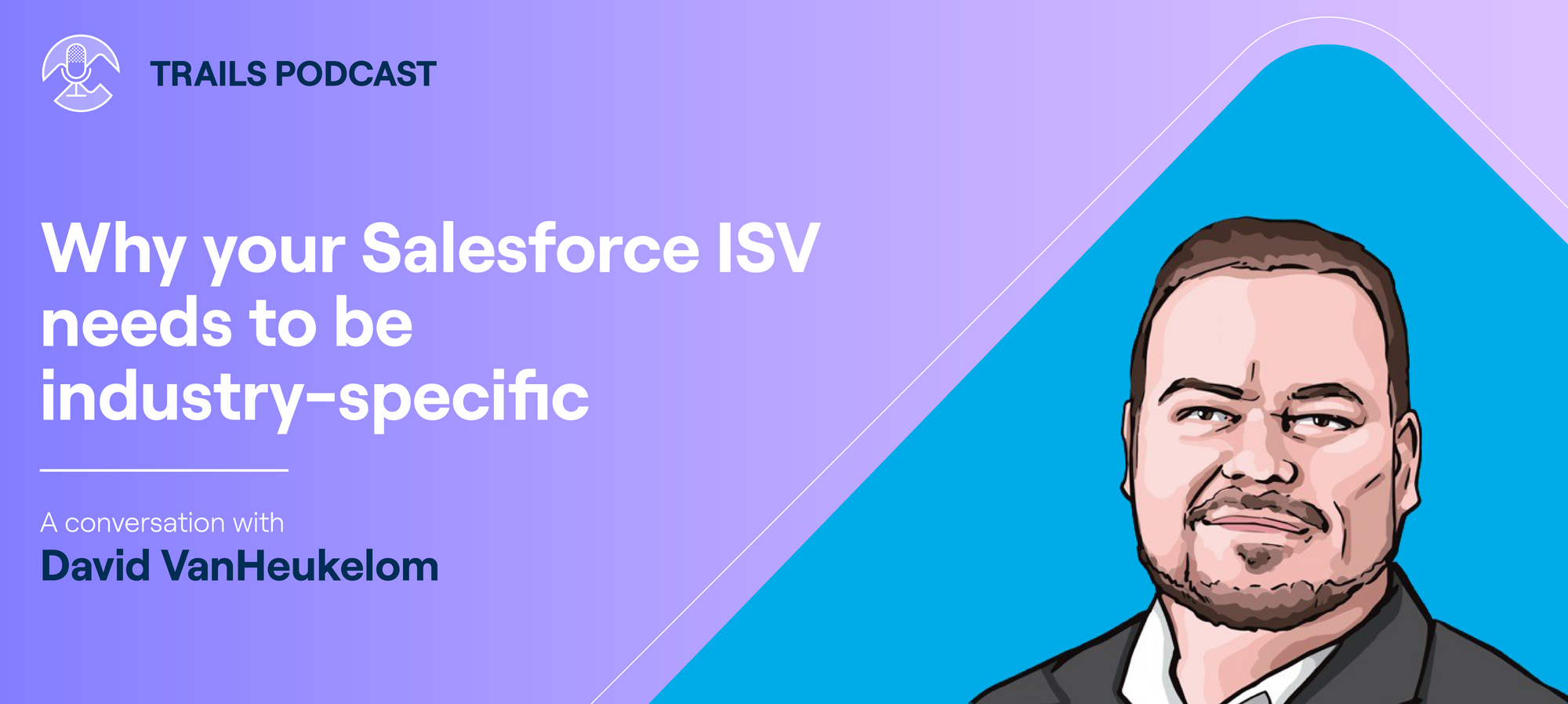How to navigate an ISV on Salesforce (Trails Podcast episode #4 with Tim Schuitemaker)
Welcome to the Trails Podcast – a show that takes you on a journey through the Salesforce ecosystem. Join us as we explore the trails of innovation, transformation, and success powered by the Salesforce platform.

Table of contents
Episode Four: Tim Schuitemaker, Managing Director of GoMeddo
This podcast episode is all about managing and navigating an ISV company within the Salesforce ISV ecosystem.
Follow along as we go through his story, insights, and tips.
Please introduce yourself, and tell us about your journey with Salesforce
I'm Tim Schuitemaker, a hard name to pronounce for most people. I'm the Managing Director of GoMeddo. We will talk about Salesforce, which has been my main job for the last 15 years.
ISVs on the AppExchange generate significant revenue. As per Salesforce, the AppExchange partner ecosystem drives over $10 billion in revenue for its partners. There are also over 10 million AppExchange installs.
Tell us about your company, GoMeddo. Which problems are you solving, and why did you build on the Salesforce platform in the first place?
GoMeddo has been an application under another name (Booker25 and Subscription25) for the last 12 years. It is a scheduling platform and a booking platform. And that also means it's pretty agnostic regarding which industries we serve.
We do everything from retail to healthcare to real estate. Well, almost any industry that you can think of that has some planning process.
Most of the time, there are multiple different aspects to the booking. If you think about a test drive in a car dealership, for example, then you need to know if the car is available, is my salesperson available, etc.
And all that needs to come together to determine if you can offer that as a potential slot. So, we do that by providing that as a self-service on our customer's website, up until payments and through a full-service cycle.
All of it is native in Salesforce. All of the data comes back into Salesforce and usually extends to other business processes that customers might have.
But in the end, it's scheduling. And almost every industry has some scheduling challenges.
When we started with GoMeddo (back then called Booker25), there were only a few scheduling possibilities on Salesforce. Now you have a couple of scheduling solutions. Salesforce has Field Service Lightning or Lightning Scheduler, which we sometimes compete against.
Field Service is for sending people on the road and keeping track of inventory, which is also different from what we're doing. We're operational planning.
How far did you take your own Salesforce skills? Do you find yourself configuring stuff, or did you do that in the early days? Did you collect a lot of Trailblazer Ranks or certifications?
Back when we started building our application, we used the second version of our application. So, the first version was created by myself and some other Developers in our team.
I started as a Developer. I then grew to become more of a Project Manager and Product Owner. And then, I ended up in the role I'm currently in as a Managing Director.
It does mean that because I have a technical background, from time to time, I still do pre-sales and sales calls, explaining how our software works from building the demos, Flows, and even building code if it is needed as part of the bigger, broader picture that we're trying to tell our customers.
How has the Salesforce ISV landscape changed since you started your company, and which things have gotten more accessible or more complicated as an ISV?
There are now more competitive products, although we're a pretty unique product in the sense that many products are focused more on appointment bookings, as we call them. It's a relatively straightforward process in which we're trying to find availability between two people.
Within the last nine years, there have been a lot more ISVs. Salesforce has grown massively, and as an ISV, you're growing automatically with them.
Salesforce has a comprehensive ISV Partner Program that offers partners support, resources, and guidance. The program includes technical enablement, co-marketing opportunities, and access to Salesforce's vast customer network.
It's not that things are becoming easier or harder. It's still the same kind of process that you go through as an ISV, where you try to build your app. It's like building any SaaS application. You're trying to develop an app that fits your customers' needs.
And your customers are now on Salesforce, which gives you a bit of a niche proposition – a big niche – because many customers are using Salesforce.
Some competition also means that there is a healthy market landscape. It means that others are also seeing the need that we're solving.
These days, more ISVs are collaborating, making success stories. I know that you had Evgenii Pavlov (CEO of flair, an HR sofware built on Salesforce) on this podcast before.
And that's also what we're doing with payment platforms. So, that's a trend I've been seeing in the last couple of years, where ISVs are looking to each other and are trying to promote their product by promoting others.
Do you find yourself selling to companies that don't use Salesforce yet?
Yeah, sometimes. Salesforce offers something they call OEM and ISVforce. One is where we're selling our product as a standalone product – the OEM one – and the other is selling it on top of whatever the customer already has within Salesforce.
Sometimes, we sell our product as an OEM because there are a lot of use cases. When it comes to a booking process, you may not want all of your users to have full access to your Salesforce data. You may want some users to only see the booking data, like incoming bookings.
That's a good use case where we sometimes combine OEM with Salesforce. We also have a couple of customers just using our platform because they are still getting a lot of value out of the reporting, dashboarding, accounts, and contact structure you get with any application built on top of Salesforce.
I must admit, however, that most of our customers are already using Salesforce in some way. I think one of the reasons is because of market penetration.
Could you tell us more about your international go-to-market playbook and how you're doing this as an ISV?
We're doing a lot of market scans these days where we're looking into where Salesforce is growing. Where Salesforce is growing means there is more market for us as well. It also means that customers are onboarding on Salesforce.
A lot or some of those customers will also require a booking platform. We're then trying to do mass marketing for brand awareness in those countries or regions. We're trying to hire salespeople in those specific language areas.
They're not tied to a country but are usually based on a language. And you start with mass marketing, which means LinkedIn campaigns and advertisements on Google or AppExchange-specific material in particular languages. And then we are also trying to do more tailored marketing approaches and actions. For example, more account-based marketing.
Of course, that also comes with specific discounts and stuff. You want to make sure that the first customers are happy. Overall, there are many new markets we are trying to grow into, and it has not always been easy.
Our go-to-market also means talking to the right people within Salesforce, being at the events, showing your face here and there, sponsoring drinks – whatever. It's just making sure people know who you are and helping them with their deals. And that will return to your business at some point as well.
Which countries have you identified where Salesforce is growing the fastest?
If you look into the global distribution of Salesforce, almost 62% of customers are located in the U.S. Next to that is the UK, the biggest market here in Western Europe. Those are the two biggest markets. That automatically means that most of our customers are located in these places.
And then, if you look at Benelux – France and Germany – they're fast-growing markets for Salesforce. You see, many new customers are being onboarded in these areas.
I see a lot of new opportunities coming in Australia. Southern Europe is growing, and the Americas as whole, like South America. Things are picking up there as well. It's a different market, though. You need to have a different message – specifically localized messages – which is a challenge in its own right.
What are you focusing on right now? What is your biggest challenge?
There are still some challenges that we have to overcome with our products. We are working hard on getting a better message out.
According to Salesforce, tracking app usage data, such as the most frequently used features or the number of logins, can help identify areas for product improvement and customer engagement.
This is part of the structure we're working on right now because we want to ensure that people understand what we're doing and how we compare to other scheduling platforms – maybe even the ones that Salesforce offers. And also how we're unique and where we offer a better experience for the end user.
That's something that we're working on quite hard these days to make industry-specific propositions, where we tell a story within an industry and how we help customers in that industry.
That's one of the main challenges I experience having made a product that's agnostic and specific for certain industries.
Are you ready to develop customer experiences on a platform you can count on?
Thank you for tuning into this episode of Hutte's Trails Podcast, where we explored the following:
- The benefits of having a niche proposition
- The competitive advantages of performing targeted outreach so that both your business and Salesforce grow together.



